
Problème
L’indicateur POWER/PROTECTOR
ne s’allume pas.
L’indicateur OVER CURRENT s’allume
en rouge.
L’indicateur OFFSET s’allume en
rouge.
L’indicateur THERMAL s’allume en
rouge.
L’alternateur émet un bruit.
Le son est étouffé.
Le son est trop faible.
Aucun son n’est audible.
Aucune tonalité de test n’est audible
lorsque la touche TEST TONE est
enfoncée.
Problem
The POWER/PROTECTOR
indicator does not light up.
The OVER CURRENT indicator lights
up in red.
The OFFSET indicator lights up in red.
The THERMAL indicator lights up in
red.
Alternator noise is heard.
The sound is muffled.
The sound is too low.
No sound is heard.
No test tone is heard when the TEST
TONE button is pressed.
Sony Corporation 2000 Printed in Korea
XM-255EX
XM-255NX
Specifications
AUDIO POWER SPECIFICATIONS
POWER OUTPUT AND TOTAL HARMONIC DISTORTION
55 watts per channel minimum continuous average power into 4 ohms,
both channels driven from 20 Hz to 20 kHz with no more than 0.04%
total harmonic distortion per Car Audio Ad Hoc Committee standards.
Other Specifications
Owner’s Record
The model and serial numbers are located on the bottom of the unit.
Record the serial number in the space provided below.
Refer to these numbers whenever you call upon your Sony dealer regarding this product.
Model No. XM-255EX Serial No.
3-045-651-11 (1)
Stereo Power
Amplifier
Operating Instructions
Mode d’emploi
Circuit system OTL (output transformerless) circuit
Pulse power supply
Inputs RCA pin jacks
High level input connector
Outputs Speaker terminals
Through out pin jacks
Speaker impedance 2 – 8 Ω (stereo)
4 – 8 Ω (when used as a bridging
amplifier)
Maximum outputs 120 W × 2 (at 4 Ω)
150 W × 2 (at 2 Ω)
300 W (monaural, at 4 Ω)
Rated outputs
(supply voltage at 14.4 V)
55 W × 2 (20 Hz – 20 kHz,
0.04 % THD, at 4 Ω)
70 W × 2 (20 Hz – 20 kHz,
0.1 % THD, at 2 Ω)
140 W (monaural) (20 Hz –
20 kHz, 0.1 % THD, at 4 Ω)
Frequency response
5 Hz – 100 kHz ( dB)
Harmonic distortion
0.005 % or less
(at 1kHz, 4 Ω)
Input level adjustment range
0.2 – 4.0 V (RCA pin jacks)
0.4 – 8.0 V (High level input)
Low-pass filter 50 – 200 Hz, –18 dB/oct
Power requirements
12 V DC car battery
(negative ground)
Power supply voltage
10.5 – 16 V
Current drain At rated output: 15 A
Remote input: 1.4 mA
Dimensions Approx. 237 × 52 × 170 mm
(9
3
/8 × 2
1
/8 × 6
3
/4 in.) (w/h/d)
not incl. projecting parts and controls
Mass Approx. 1.5 kg (3 lb. 5 oz.) not incl.
accessories
Supplied accessories
Mounting screws (4),
Terminal cap (1)
Optional accessories
Connecting cord for power amplifier
RC-46
Design and specifications are subject to change without
notice.
Troubleshooting Guide
The following checklist will assist in the correction of most problems which you may encounter with your unit.
Before going through the checklist below, refer to the connection and operating procedures.
Cause/Solution
The fuse is blown. t Replace the fuse with a new one.
The ground lead is not securely connected. t Fasten the ground lead securely to
a metal surface of the car.
The voltage going into the remote terminal is too low.
•
The connected master unit is not turned on.
t
Turn on the master unit.
• The system employs too many amplifiers. t Use a relay.
Check the battery voltage (10.5 – 16 V).
Turn off the power switch. The speaker outputs are short-circuited. t Rectify
the cause of the short-circuit.
Turn off the power switch. Make sure the speaker cord and ground lead are
securely connected.
The unit heats up abnormally.
• Use speakers with suitable impedance (2 to 8 ohms).
• Make sure to place the unit in a well ventilated location.
The power connecting leads are installed too close to the RCA pin cords. t Keep
the leads away from the cords.
The ground lead is not securely connected. t Fasten the ground lead securely to
a metal surface of the car.
Negative speaker leads are touching the car chassis. t Keep the leads away
from the car chassis.
The FILTER selector switch is set to the “LPF” position.
The LEVEL adjustment control is set to the “MIN” position.
The FILTER selector switch is settled between settings (i.e., not correctly set); set
the switch properly.
The wiring is not properly connected. t Check the connections and re-wire
accordingly.
Guide de dépannage
La liste suivante vous permettra de remédier à la plupart des problèmes que vous pourriez rencontrer dans
le cadre de l’utilisation de votre appareil. Avant de passer en revue la liste ci-dessous, vérifiez les
procédures de raccordement et d’utilisation.
Cause/Solution
Le fusible est grillé. t Remplacez le fusible par un neuf.
Le fil de masse n’est pas connecté correctement. t Fixez correctement le fil de
masse à un point métallique de la voiture.
La tension entrant à la borne de télécommande est trop faible.
• L’appareil maître connecté n’est pas allumé. t Mettez l’appareil maître sous
tension.
• Le système utilise trop d’amplificateurs. t Utilisez un relais.
Vérifiez la tension de la batterie (10,5 – 16 V).
Coupez l’interrupteur d’alimentation. Les sorties de haut-parleur sont court-
circuitées. t Remédiez à la cause du court-circuit.
Coupez l’interrupteur d’alimentation. Assurez-vous que le cordon de haut-
parleur et le fil de masse sont correctement branchés.
L’appareil chauffe anormalement.
• Utilisez des haut-parleurs d’une impédance appropriée (2 à 8 ohms).
• Installez l’appareil dans un endroit bien aéré.
Les câbles d’alimentation sont installés trop près des câbles à broches RCA.
t Eloignez les câbles l’un de l’autre.
Le fil de masse n’est pas connecté correctement. t Fixez correctement le fil de
masse à un point métallique de la carrosserie.
Les fils négatifs des haut-parleurs touchent la carrosserie de la voiture.
t Eloignez les fils de la carrosserie de la voiture.
Le sélecteur FILTER est mis en position “LPF”.
La commande de réglage LEVEL est mise en position “MIN”.
Le sélecteur FILTER est à cheval entre deux positions de réglage (ou n’est pas
correctement réglé) ; réglez correctement le sélecteur.
Les fils ne sont pas correctement connectés. t Vérifiez les connexions et refaites
le câblage en conséquence.
+0
–3
Spécifications
Circuiterie Circuit OTL (sortie sans
transformateur)
Alimentation par impulsions
Entrées Prises à broche RCA
Connecteur d’entrée haut niveau
Sorties Bornes de haut-parleurs
Prises à broches à sortie directe
Impédance des haut-parleurs
2 – 8 Ω (stéréo)
4 – 8 Ω (en cas d’utilisation comme
amplificateur en pont)
Sorties maximales 120 watts × 2 (à 4 Ω)
150 watts × 2 (à 2 Ω)
300 watts (monaural, à 4 Ω)
Sorties nominales (tension d’alimentation à 14,4 V)
55 watts × 2 (20 Hz – 20 kHz, 0,04 %
DHT, à 4 Ω)
70 watts × 2 (20 Hz – 20 kHz, 0,1 %
DHT, à 2 Ω)
140 watts (monaural) (20 Hz –
20 kHz, 0,1 % DHT, à 4 Ω)
Réponse en fréquence
5 Hz – 100 kHz ( dB)
Distorsion harmonique
0,005 % ou inférieure
(à 1kHz, 4 Ω)
Plage de réglage du niveau d’entrée
0,2 – 4,0 V (prises à broche RCA)
0,4 – 8,0 V (entrée haut niveau)
Filtre passe-bas 50 – 200 Hz, –18 dB/oct
Alimentation Batterie de voiture 12 V CC
(masse négative)
Tension d’alimentation
10,5 – 16 V
Courant à la sortie nominale: 15 A
Entrée de télécommande: 1,4 mA
Dimensions Approx. 237 × 52 × 170 mm
(9
3
/8 × 2
1
/8 × 6
3
/4 po.) (l/h/p)
à l’exclusion des parties et commandes
saillantes
Poids Approx. 1,5 kg (3 livres 5 onces) sans
les accessoires
Accessoires fournis
Vis de montage (4),
Cache de borne (1)
Accessoires en option
Câble de raccordement pour
amplificateur de puissance RC-46
La conception et les spécifications sont sujettes à
modifications sans préavis.
+0
–3
If you have any questions or problems concerning your unit that are not covered in this manual, please
consult your nearest Sony dealer.
Si vous avez des questions ou des problèmes concernant votre appareil qui ne sont pas abordés dans ce
mode d’emploi, adressez-vous à votre distributeur Sony le plus proche.

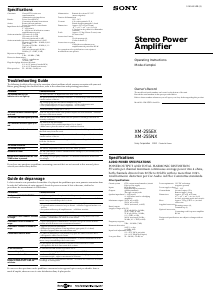


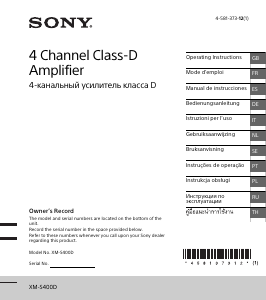
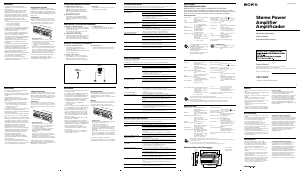

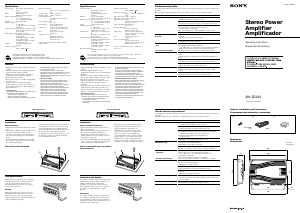
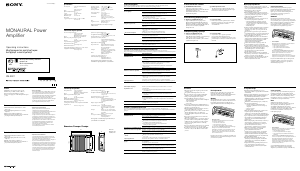
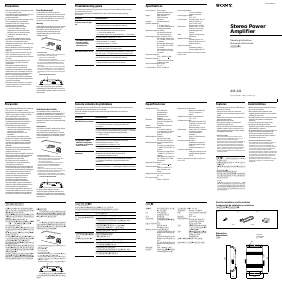
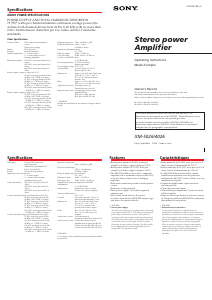
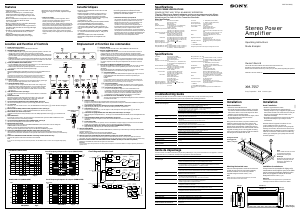
Join the conversation about this product
Here you can share what you think about the Sony XM-255EX Car Amplifier. If you have a question, first carefully read the manual. Requesting a manual can be done by using our contact form.